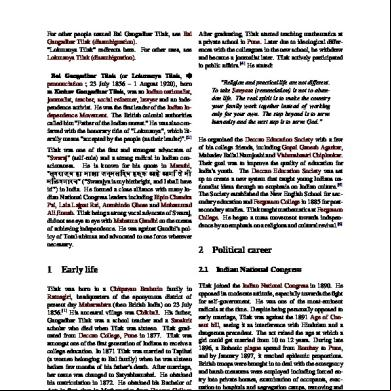Bal Gangadhar Tilak _social Contributions And Legacy 73o5h
This document was ed by and they confirmed that they have the permission to share it. If you are author or own the copyright of this book, please report to us by using this report form. Report 3b7i
Overview 3e4r5l
& View Bal Gangadhar Tilak _social Contributions And Legacy as PDF for free.
More details w3441
- Words: 576
- Pages: 2
Social contributions and legacy[edit] Further information: Sarvajanik Ganeshotsav and Kesari (newspaper) Tilak started two weeklies, Kesari ("The Lion") in Marathi and Mahratta in English[18] in 1880–81 with Gopal Ganesh Agarkar as the first editor. By this he was recognized as 'awakener of India'. As Kesari later became a daily and continues publication to this day. In 1894, Tilak transformed the household worshipping of Ganesha into a grand public event (Sarvajanik Ganeshotsav) in that house. The celebrations consisted of several days of processions, music and food. They were organized by the means of subscriptions by neighbourhood, caste, or occupation. Students often would celebrate Hindu and national glory and address political issues; including patronage of Swadeshi goods.[9]:152 In 1895, Tilak founded the Shri Shivaji Fund Committee for celebration of "Shiv Jayanti", the birth anniversary of Chhatrapati Shivaji, the founder of 17th centuryMaratha Empire. The project also had the objective of funding the reconstruction of the tomb (Samadhi) of Shivaji at Raigad Fort. For this second objective, Tilak established the Shri Shivaji Raigad Smarak Mandal along with Senapati Khanderao Dabhade II of Talegaon Dabhade, who became the founder President of the Mandal. The events like the Ganapati festival and Shiv Jayanti were used by Tilak to build a national spirit beyond the circle of educated elite in opposition to colonial rule. But it also exacerbated HinduMuslim differences. The festival organizers would urge Hindus to protect cows and boycott the Muharram celebrations organized byShi'a Muslims, in which Hindus had formerly often participated. Thus, although the celebrations were meant to be a way to oppose colonial rule, they also contributed to religious tensions.[9]:152 Contemporary Marathi Hindu nationalist parties like the Shivsena took up his reverence for Shivaji. The Deccan Education Society that Tilak founded with others in the 1880s still runs Institutions in Pune like the Fergusson College. The Swadeshi movement started by Tilak at the beginning of the 20th century became part of the Independence movement until that goal was achieved in 1947. One can even say Swadeshi remained part of Indian Government policy until the 1990s when the Congress Government liberalised the economy.[19] Tilak Smarak Ranga Mandir, a theatre auditorium in Pune is dedicated to him. In 2007, the Government of India released a coin to commemorate the 150th birth anniversary of Tilak.[20][21] Tilak said, "I regard India as my Motherland and my Goddess, the people in India are my kith and kin, and loyal and steadfast work for their political and social emancipation is my highest religion and duty".[22] Swami Vivekananda reached Pune by train during September 1892. Tilak happened to be his fellow enger. Vivekananda stayed in his house "Vinchurkar Wada" in Pune.[23][better source needed]
Books[edit]
In 1903, he wrote the book The Arctic Home in the Vedas. In it, he argued that the Vedas could only have been composed in the Arctics, and the Aryan bards brought them south after the onset of the last ice age. He proposed a new way to determine the exact time of the Vedas.[24] He tried to calculate the time of Vedas by using the position of different Nakshatras. Positions of Nakshtras were described in different Vedas.
Tilak authored "Shrimadh Bhagvad Gita Rahasya" in prison at Mandalay – the analysis of 'Karma Yoga' in the Bhagavad Gita, which is known to be gift of the Vedas and the Upanishads.
Being a devotee of Gajanan Maharaj of Shegaon, many reference texts of his are available in the epic.
Books[edit]
In 1903, he wrote the book The Arctic Home in the Vedas. In it, he argued that the Vedas could only have been composed in the Arctics, and the Aryan bards brought them south after the onset of the last ice age. He proposed a new way to determine the exact time of the Vedas.[24] He tried to calculate the time of Vedas by using the position of different Nakshatras. Positions of Nakshtras were described in different Vedas.
Tilak authored "Shrimadh Bhagvad Gita Rahasya" in prison at Mandalay – the analysis of 'Karma Yoga' in the Bhagavad Gita, which is known to be gift of the Vedas and the Upanishads.
Being a devotee of Gajanan Maharaj of Shegaon, many reference texts of his are available in the epic.





